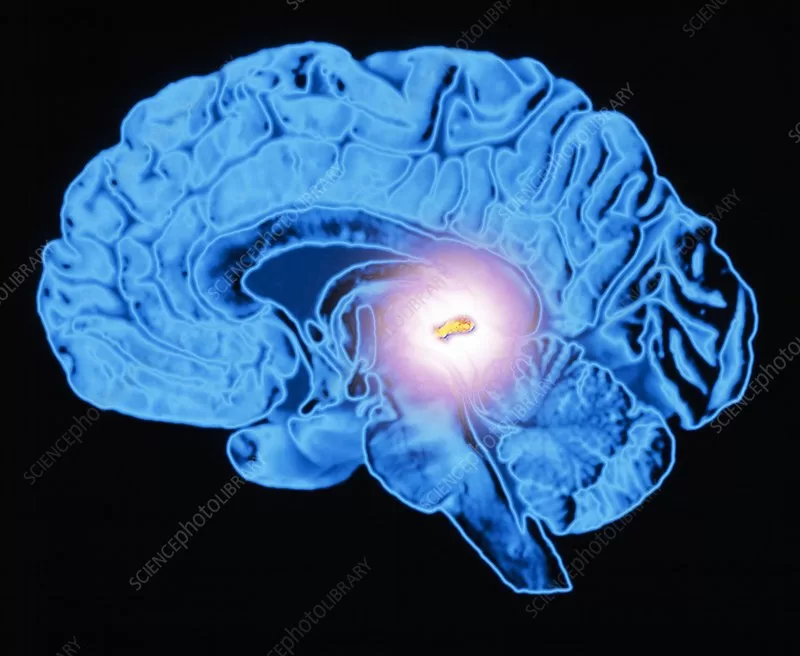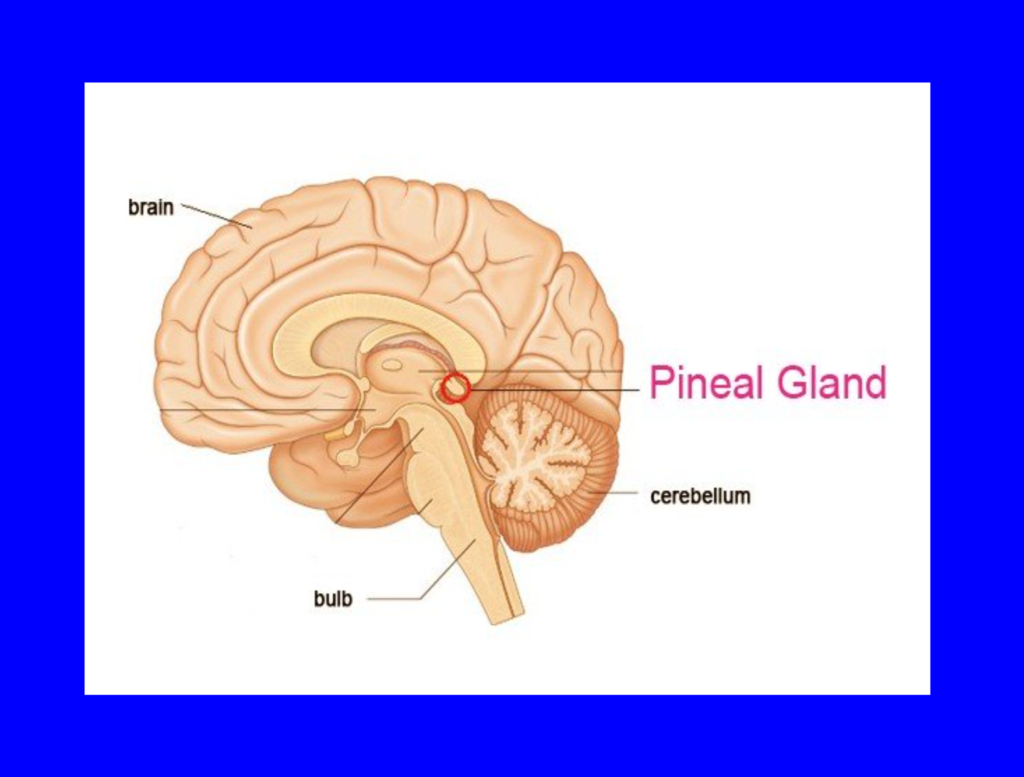The spiritual power of the pineal gland has been a subject of fascination and exploration for millennia across various cultures and belief systems. Located in the center of the brain, the pineal gland, often referred to as the “third eye,” is a small endocrine gland responsible for producing melatonin, which regulates our sleep-wake cycles. However, beyond its physiological functions, the pineal gland is also believed to have profound spiritual significance.
The Ancient Traditions and Penial Awakening
In ancient spiritual traditions, such as Hinduism and Buddhism, the pineal gland is considered the gateway to higher consciousness and spiritual awakening. It is often associated with the “ajna” or “brow chakra,” which represents intuition, perception, and inner wisdom. Through meditation and spiritual practices, individuals seek to activate and open their third eye to gain access to higher levels of awareness and understanding.

Many mystics and spiritual seekers believe that the pineal gland can serve as a channel to connect with the divine and access higher dimensions. It is said to be the seat of intuition and the source of spiritual guidance, providing individuals with a deeper understanding of their purpose and the universe’s interconnectedness. Activating the pineal gland is often viewed as a way to transcend the limitations of the physical world and experience a heightened sense of spiritual unity.
Moreover, some esoteric teachings propose that the pineal gland is the physical counterpart of the “mind’s eye,” allowing individuals to perceive spiritual realms and visions beyond ordinary sensory experiences. This inner vision is considered a powerful tool for self-discovery, spiritual growth, and navigating one’s journey in life with clarity and purpose.
However, it is essential to note that the spiritual power of the pineal gland is a topic of debate among scientists and spiritual practitioners alike. While some argue that it holds the potential for spiritual insights and experiences, others maintain a more skeptical viewpoint, attributing such experiences to psychological or neurological processes.
Why is the pineal gland spiritual?
The belief in the spiritual significance of the pineal gland is rooted in various cultural and esoteric traditions, as well as certain metaphysical and philosophical concepts. Here are some reasons why the pineal gland is considered spiritual in these contexts:
Historical and Cultural Significance:
The pineal gland’s association with spirituality can be traced back to ancient civilizations like the Egyptians and Greeks. René Descartes, a philosopher in the 17th century, referred to the pineal gland as the “seat of the soul.” Over time, this historical and cultural significance has contributed to its spiritual symbolism.
The Third Eye Concept:
The pineal gland is often linked to the concept of the “third eye” found in various spiritual traditions, such as Hinduism, Buddhism, and New Age beliefs. The third eye is believed to be a spiritual organ that provides insights beyond ordinary perception, allowing individuals to access higher realms of consciousness and spiritual awareness.
Connection to Inner Wisdom:
In spiritual teachings, the pineal gland is sometimes associated with the sixth chakra or “brow chakra,” which is related to intuition, insight, and inner wisdom. Activating or “opening” the third eye is thought to enhance one’s ability to perceive spiritual truths and gain a deeper understanding.
Connection with Light and Higher Consciousness:
The pineal gland’s association with light is another reason for its spiritual connotations. Some spiritual traditions consider light to be a symbol of divine consciousness, and the pineal gland has photoreceptive cells similar to those found in the retina of the eyes. This has led some to believe that the pineal gland may play a role in perceiving spiritual light or visions.
Meditation and Spiritual Practices:
Many spiritual practices, such as meditation and certain yoga techniques, focus on the third eye area to enhance spiritual experiences and promote self-awareness. By concentrating on the pineal gland during these practices, individuals may seek to awaken their spiritual potential and access higher states of consciousness.
Connection with the Divine:
Some spiritual seekers believe that the pineal gland acts as a gateway to connect with the divine or higher realms. It is thought to facilitate communication with higher beings, spirit guides, or the collective unconscious.
It is important to note that the spiritual significance of the pineal gland is largely based on metaphysical beliefs and is not scientifically proven. While the pineal gland plays a crucial role in regulating the sleep-wake cycle through the production of melatonin, its alleged spiritual attributes remain a matter of personal faith and interpretation rather than empirical evidence. As with many spiritual concepts, the interpretation and understanding of the pineal gland’s spiritual nature can vary widely among different individuals and belief systems.
The function of the pineal gland in the soul
The concept of the pineal gland’s function in the soul is primarily rooted in spiritual and metaphysical beliefs rather than scientifically established facts. In various spiritual and esoteric traditions, this gland is often associated with the soul or considered to play a role in the soul’s experiences and connection to higher consciousness. However, it’s essential to recognize that these beliefs are speculative and not supported by empirical evidence. Here are some common spiritual perspectives on the pineal gland’s function in the soul:
Gateway to Higher Realms: One belief is that the pineal gland serves as a gateway or portal to higher dimensions and spiritual realms. In this view, the soul can access higher consciousness and divine knowledge through the activation and awakening of the pineal gland, often referred to as the “third eye.”
Connection to Intuition and Inner Wisdom: Some spiritual teachings associate the pineal gland with the sixth chakra or “brow chakra,” which is linked to intuition and inner wisdom. According to this perspective, the pineal gland may provide insights and guidance to the soul, facilitating spiritual growth and self-awareness.
Seat of Consciousness: In certain spiritual philosophies, the pineal gland is considered the physical counterpart of the soul’s consciousness. It is believed to hold the essence of individual identity and consciousness, acting as a bridge between the physical body and the soul or higher self.
Perception of Spiritual Light: The pineal gland’s photoreceptive properties have led to the belief that it may have the ability to perceive spiritual light or divine energies. This notion suggests that the soul can experience profound spiritual visions and revelations through the activation of the pineal gland.
Communication with the Divine: Some spiritual seekers view the pineal gland as a tool for communication with the divine or spiritual entities. It is believed that the soul can establish a direct connection with higher beings or spiritual guides through the pineal gland’s supposed abilities.
It is crucial to emphasize that these beliefs about the pineal gland’s role in the soul are not universally accepted, and exist in the realm of spirituality, mysticism, and personal interpretation. The pineal gland’s primary physiological function is the regulation of the sleep-wake cycle through the production of melatonin, a hormone that influences sleep patterns.
While spirituality and science often intersect in exploring human experiences and consciousness, the function of the pineal gland in the soul remains a topic of debate and contemplation among different belief systems and individuals. As with many spiritual concepts, the understanding of the pineal gland’s role in the soul may vary widely depending on one’s cultural background, personal beliefs, and philosophical inclinations.
Do Pineal glands secrete Devine nectar?
It is essential to clarify that the idea of the pineal gland secreting nectar in the context of Khechari Mudra is a concept primarily found in certain yogic and esoteric traditions. From a scientific standpoint, the pineal gland secretes melatonin, a hormone responsible for regulating sleep-wake cycles, and there is no empirical evidence supporting the secretion of a substance called “nectar” in the traditional sense. However, let’s explore how this concept is understood within specific spiritual practices:

Khechari Mudra:
Khechari Mudra is a yogic practice where the practitioner rolls their tongue backward to touch the soft palate and, with consistent practice, may eventually be able to extend the tongue to the nasal cavity. This advanced technique is said to stimulate the area around the pineal gland.
Amrita (Nectar):
In yogic and spiritual terminology, “Amrita” is sometimes referred to as the “nectar of immortality” or “divine nectar.” It is considered a subtle substance that has transformative and spiritual qualities, often associated with profound bliss, self-realization, and higher states of consciousness.
Activation of Pineal Gland:
According to certain esoteric traditions, the Khechari Mudra is believed to exert pressure on the area around the pineal gland, stimulating and awakening it. This activation is thought to enhance the gland’s functioning, leading to the release of the metaphorical “nectar” known as Amrita.
Self-Realization and Higher Consciousness:
The activation of the pineal gland and the supposed secretion of Amrita are thought to have transformative effects on the practitioner. It is believed to facilitate spiritual experiences, deeper meditative states, and ultimately, self-realization or enlightenment.
Symbolic Interpretation:
It’s crucial to understand that in these spiritual practices, the term “nectar” is often used symbolically to represent the transformative and enlightening experiences that can arise from specific yogic practices. It may not be a physical substance but rather a metaphorical description of the profound spiritual insights and heightened states of consciousness that can be attained through dedicated practice.
It is important to approach such esoteric concepts with an open mind and understand that the explanations surrounding the pineal gland’s role and the concept of “nectar” are deeply rooted in ancient spiritual traditions. While these practices have been part of various yogic and tantric traditions, they are considered advanced and are typically taught under the guidance of experienced practitioners or spiritual teachers. As with any spiritual practice, individual experiences and interpretations may vary, and it is essential to approach such practices with respect, caution, and a proper understanding of their cultural and historical contexts.
Activating the pineal gland spiritually
Activating the pineal gland spiritually is a concept found in various spiritual traditions, and it is often associated with expanding consciousness, gaining deeper insights, and connecting with higher realms. Keep in mind that this process is subjective and might not have scientific evidence to support it. Here are some general practices that are believed to promote pineal gland activation from a spiritual perspective:
Meditation and Mindfulness:
Regular meditation and mindfulness practices are often recommended to activate the pineal gland. Meditation helps calm the mind, quiet mental chatter, and create a conducive environment for spiritual experiences. Focused meditation on the third eye or the area of the pineal gland may be particularly beneficial.
Surya Namaskaram or Sun Gazing:
Some spiritual teachings suggest that gazing at the sun during specific safe hours (usually early morning or late evening) or early morning Surya namaskaram, can stimulate the pineal gland. However, it’s crucial to approach sun gazing with caution and seek expert guidance, as direct sunlight can harm the eyes. Surya Namaskar is a kind of asana and can be practiced with the proper spiritual guidance of Yoga.
Breathwork and Pranayama:
Certain breathing techniques, like alternate nostril breathing (Nadi Shodhana) or deep belly breathing (Diaphragmatic breathing), are believed to purify the energy channels in the body and enhance spiritual awareness, potentially benefiting the pineal gland.
Visualization:
Practicing visualization techniques, where you imagine a radiant and vibrant light at the center of your forehead (the location of the pineal gland), can help focus energy and attention on that area, aiding in its activation.
Avoiding Toxins:
Some spiritual practices suggest avoiding or reducing the intake of toxins that might calcify the pineal gland, such as fluoride in water and certain processed foods. Instead, opt for a healthy and balanced diet.
Sound Healing:
Listening to specific frequencies or using sound healing practices, such as chanting mantras or using Tibetan singing bowls, is believed to resonate with the pineal gland and promote its activation.
Intention Setting and Affirmations:
Setting clear intentions and using positive affirmations related to spiritual growth and pineal gland activation can be beneficial during meditation or other practices.
Herbs and Supplements:
Some spiritual practitioners use specific herbs or supplements, such as gotu kola, spirulina, or melatonin supplements, to support pineal gland function. However, it’s crucial to consult with a healthcare professional before using any supplements.
Yoga Asanas:
Certain yoga poses, such as Sarvangasana (Shoulder Stand) or Halasana (Plow Pose), are believed to stimulate the area of the pineal gland and the corresponding chakras.
Gratitude and Love:
Cultivating a sense of gratitude and love towards oneself and others is considered to raise one’s vibrations and promote spiritual growth, which may also support pineal gland activation.
Remember, the pineal gland’s spiritual activation is a personal journey, and experiences may vary significantly among individuals. It is essential to approach these practices with an open mind, patience, and consistency. Furthermore, always seek guidance from experienced spiritual teachers or practitioners to ensure safe and appropriate practices.

Conclusion
The spiritual power of the pineal gland is a concept deeply rooted in various ancient and modern spiritual traditions. It is associated with higher consciousness, inner wisdom, and the ability to connect with the divine. Whether regarded as a physiological gland with spiritual significance or an esoteric gateway to higher dimensions, the exploration of the pineal gland’s potential remains an intriguing and profound aspect of human spirituality and self-discovery.
It is often felt that the pineal gland and its activation is a captivating and mysterious realm that has intrigued spiritual seekers and mystics for ages. As the ancient “third eye” of consciousness, this small gland holds the promise of higher states of awareness, self-realization, and profound spiritual experiences. While scientific evidence may be limited in validating its metaphysical attributes, the pineal gland’s significance in various spiritual traditions persists as a potent symbol of human potential and connection to the divine.
Through practices like meditation, visualization, and mindfulness, individuals embark on a transformative journey, seeking to unlock the hidden potentials of the pineal gland and awaken the inner eye to perceive the boundless realms of spirituality. Ultimately, the quest for spiritual enlightenment through the pineal gland’s activation is a deeply personal and awe-inspiring exploration of the interconnectedness of the mind, body, and soul.
Disclaimer:
The author’s views are his or her own. The facts and opinions in the article have been taken from various articles and commentaries available in the online media and Eastside Writers does not take any responsibility or obligation for them.
Note: Contact our Writers at www.eastsidewriters.com for writing Blogs/Articles on any niche. We have experts in various domains from Technology to Finance and from Spirituality to Lifestyle and Entertainment.







Pingback: Exploring the Pursuit of Moksha and Samadhi in Life: Balancing Enjoyment and Spiritual Liberation - Eastside Writers
Pingback: Exploring Tantra Meditation for Inner Peace and Wellness - Eastside Writers
Pingback: Aham Asmi: A Journey to Personal Fulfillment and Universal Connection - Eastside Writers
Pingback: Unlocking Holistic Growth Through The Power Of Seva-The Art Of Selfless Service - Eastside Writers
Pingback: The True Wealth: Why Peace of Mind Outweighs Money as the Ultimate Motivator - Eastside Writers